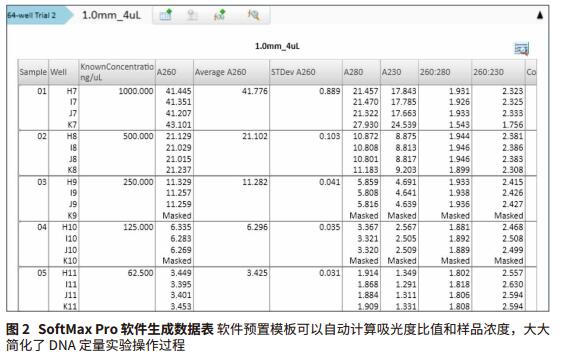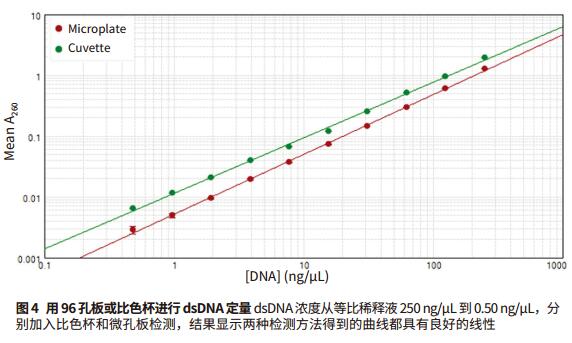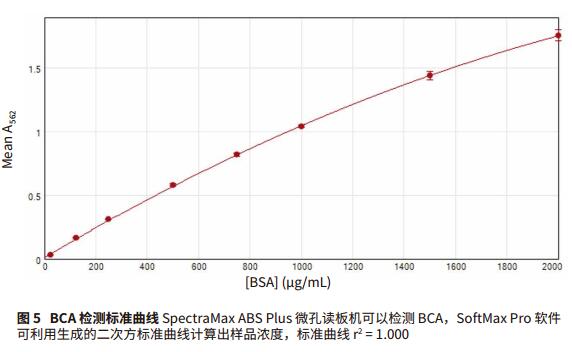How to use the SpectraMax ABS Plus microplate reader for high-throughput detection of trace DNA and proteins
Introduction
In genetics and molecular biology, quantification of nucleic acids and proteins is an essential upstream assay for many complex experiments. Although there are many methods of detection, the most commonly used is still UV spectrophotometry. The principle of the ultraviolet spectrophotometry is to use the molecules to absorb light and scattered light in a fixed wavelength range, and calculate the concentration of the substance to be tested based on Lambert Beer's law (Equation 1). This method also requires knowing in advance the molar extinction coefficient and path length of the sample.
A = εcL
Equation 1: Lambert Beer's law means that the absorbance (A) is equal to the molecular molar extinction coefficient (ε) multiplied by the concentration (c) and the path length (L). After changing the equation, we can use the absorbance to calculate the concentration.
Nucleic acid quantification is already a very mature detection technique, and its detection principle has not changed much compared to the original. We can detect nucleic acid concentrations at 260 nm and detect sample purity using 230 nm and 280 nm wavelengths.
We can also quantify protein samples by UV spectrophotometry, but there are more accurate colorimetric assays. Ultraviolet spectrophotometry utilizes the aromatic structural properties of tryptophan to absorb light at a wavelength of 280 nm. The calculation of the concentration depends on the different levels of tryptophan residues on the amino acid sequence. In addition, the bisquinolinecarboxylic acid (BCA) protein assay can detect protein concentration independent of amino acid sequence and length. This method is carried out by using a biuret reaction under alkaline conditions to form a colored chelate compound between the amino acid skeleton and the copper ion.
SpectraMax® ABS Plus is an ideal UV-visible microwell reader for these quantitative experiments. Here, we will show several different ABS Plus reader and SpectraDrop TM MicroVolume Microplate and SoftMax® ProSoftware combining method for quantitative detection of double stranded DNA and bovine serum albumin (BSA) was.
Advantage
- Wider wavelength detection range: 190 - 1000 nm
- Combined with the use of ultra-microplates, the sample loading can be greatly saved
- SoftMax Pro software preset templates make operation easier
material
- SpectraMax ABS Plus Microplate Reader (Molecular Devices cat. #ABS Plus)
- SpectraDrop Ultra Microplate (Molecular Devices cat. #0200-6262)
- 96-hole flat transparent plastic plate (Greiner Bio-Onecat. #655101)
- UltraPure TM Calf Thymus DNA Solution (ThermoFisher Scientific cat. #15633019)
- Pierce BCA Protein Quantitation Kit (ThermoFisher Scientific cat. #23225)
- Pierce TM bovine serum albumin standards Ampules, 2mg / mL (. ThermoFisher Scientific cat # 23209)
- UV-Star® 96-well plate (Greiner Bio-Onecat. #655801)
method
DNA quantification
1000 ng/μL of ultrapure calf thymus double-stranded DNA diluted in 1x PBS. Add 2 or 4 μL of sample to a 64-well SpectraDrop microplate and cover the sample with a 0.5 mm or 1.0 mm coverslip. Open the pre-programmed program "SpectraDrop DNA Quantitation" in the SoftMax Pro software and read the board according to the default settings. The data results are represented by a double logarithmic curve and the SoftMax Pro software further generates a standard curve. In addition, sample purity can be detected by a spectral scan with a range of 220 nm to 350 nm and a step of 4 mm.
We also compared the advantages and disadvantages of DNA quantification using cuvettes and microplates. The sample to be tested is diluted to 250 ng/μL to 0.5 ng/μL, and then added to a UV-transparent 96-well microplate (200 μL per well) or UV-visible cuvette (1000 μL). We used a SpectraMax ABS Plus microplate reader to test the sample at 260 nm. The data results are represented by a double logarithmic curve and the SoftMax Pro software further generates a standard curve.
Protein quantification
The protein samples were diluted according to the procedures provided in the BCA Experimental Kit and a standard curve was performed. Add 25 μL of protein standard and 200 μL of BCA reaction to a 96-well microplate for 30 min at 37 °C. Open the preset program “BCA†with SoftMax Pro software and read at 562 nm. The data was fitted with a quadratic curve and a standard curve was generated using SoftMax Pro software.
result
The ABS Plus Microplate Reader quantifies double-stranded DNA concentrations in both micro and standard microplate formats. Using the SpectraDrop microplate and preset program, the ABS Plus microplate reader can detect samples up to 2 ng in volume down to 2 ng/μL and can simultaneously calculate calculation parameters such as A 260 / A 280 and A 260 / A 230 ratio (Figure 1 and Figure 2). Spectral scanning can further detect if the sample is contaminated (Figure 3). In addition, the ABSPlus microplate reader can quantify double-stranded DNA using the microplate method. Using a UV-transparent microplate, the reader can detect double-stranded DNA at concentrations as low as 0.02 ng/μL (Figure 4). Finally, the SpectraMax ABSPlus Microplate Reader can detect protein concentrations based on BCA concentration assays. Follow the procedure in the kit instructions to determine the BSA standard concentration and plot a standard curve (Figure 5).





in conclusion
The SpectraMax ABS Plus Microplate Reader is a simple and reliable instrument that supports a variety of detection methods, such as cuvettes and microplates, for microplate assays for nucleic acid and protein quantification. When used with SpectraDrop ultra-microplates, this reader can quantify 64 volumes down to 2 μL at a time. In addition, SoftMax Pro software's preset template program optimizes experimental conditions and results faster.
The generic name of VTM Virus Sampling Tube is a single-use virus sampling tube, which is generally used for the detection and sampling of infectious pathogenic microorganisms in disease control departments and clinical departments. It is suitable for detection and sampling of influenza viruses (including general influenza, highly pathogenic viruses, H1N1 influenza virus, etc.), hand, foot and mouth virus, new coronavirus, measles and rubella and other types of viruses. VTM virus sampling tube can also be used for detection and sampling of Mycoplasma, Chlamydia and Ureaplasma urealyticum.
The virus and related samples in the VTM virus sampling tube should be stored and transported within 48 hours in a refrigerated state (2-8°C). Viruses and related samples can be stored for a long time in -80℃ environment or liquid nitrogen environment. The virus can maintain the activity of the virus in a lower temperature range, reduce the speed of virus decomposition, and improve the positive rate of virus isolation.
The VTM virus sampling tube is generally equipped with a disposable flocking swab. From the appearance point of view, the flocking swab is white and soft. Using this soft brush during the sampling process will make the user feel no foreign body, and it is suitable for different Partial sampling person. Moreover, the flocking swab is designed with a breaking point that conforms to the length of the sampling tube and the natural orifice of the human body, which is not only convenient for sampling but also convenient for transportation of the specimen.
Biomed Vtm Kit,Vtm Test Kit,Saliva Collection Tube,Virus Sample Collection Tube
Jilin Sinoscience Technology Co. LTD , https://www.jilinsinoscience.com